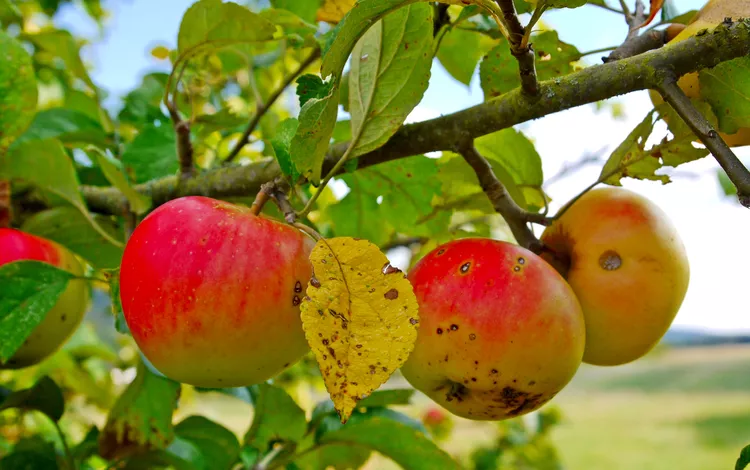The 6 Most Common Apple Tree Diseases and How to Prevent Them

Apple trees can struggle with numerous diseases, but don't let that stop you from planting and enjoying these productive fruit trees right in your backyard. While apples are attacked by a variety of bacteria and fungi, there are 6 common culprits that do most of the damage. A few easy tactics will help you combat these apple tree diseases to ensure you get a bountiful harvest. The first step in the fight for fruit begins with identifying the tree disease you are dealing with. Check out the 6 profiles below to determine what disease might be attacking your tree. Then you can take the right steps to get rid of it. And before you know it, you'll be biting into a homegrown apple.
Apples harvested from backyard trees rarely resemble their grocery store counterparts. Expect homegrown fruit to have a few blemishes and sport some odd shapes. A wide variety of fruit sizes and unique color combinations are common too. Apples you grow yourself may look far from perfect, but their flavor more than makes up for this fact. Take a bite of a freshly picked apple and you'll quickly taste the difference between it and a grocery store apple.
Plant Disease-Resistant Apple Cultivars
The easiest way to grow bushels of delicious apples without having to use pesticide sprays is to plant disease-resistant cultivars. Cornell University developed a helpful ranking of apple disease susceptibility so you can consider your best options at a glance. Dr. Suzanne Slack, an Extension fruit crops specialist at Iowa State University, considers resistant cultivars the very best tactic for reducing apple disease. Her favorite disease-resistant apple cultivars include 'Crimson Crisp', 'Enterprise', 'Galarina', 'Goldrush', 'Liberty', 'Pristine', and 'Redfree'.
Common Apple Tree Diseases
There are 6 "major players" when it comes apple diseases, says Slack. Known to greatly reduce or even eliminate a harvest and weaken the tree, these diseases make apple growing a challenge. When disease does take hold, identify it early to slow the spread. And remember, plant resistant cultivars to reduce disease in general.
1. Apple Scab
What it looks like: Apple scab begins in spring with small olive green to black spots on the leaves. The spots can affect the entire leaf, causing it to turn brown and fall off. Apple scab creates slightly raised black spots on fruits.
Control and prevention: Chemical control can reduce an infection but it's challenging to apply at just the right times. Apple scab resistant cultivars are the best way to prevent an infestation. Raking and removing leaves around trees in fall will reduce a source of infection.
2. Cedar Apple Rust
What it looks like: Bright orange-yellow, raised spots on leaves are a sure sign of cedar apple rust. The spots develop in mid- to late spring and often cause leaves and fruit to drop. The fruit that does hang on the tree is often small and malformed.
Control and prevention: Cedar apple rust is caused by a fungus that makes its primary home in eastern red cedar trees and other junipers. If possible, remove any junipers growing within 200 feet of an apple tree. Many cedar apple rust resistant apple cultivars are available.
3. Fire Blight
What it looks like: When fire blight is present, an apple tree's flowers and young twigs appear wilted and shriveled. They quickly turn black. The young twigs die and remain on the tree, bending over to form a shepherd's crook as the disease moves down the branch. Dead leaves usually remain attached to the dead branch; the tree looks like it was scorched by fire.
Control and prevention: Remove infected twigs by cutting them 12 to 18 inches below any sign of infected tissue. Disinfect pruning tools between cuts using a solution of 1 part household bleach to 9 parts water. Fire blight resistant cultivars are the best way to prevent the disease.
4. Powdery Mildew
What it looks like: Powdery mildew is present when gray-white powdery patches develop on new shoots and leaves. New growth is usually stunted, curled, or distorted on a plant with powdery mildew. The fungi that cause this disease is especially prevalent during hot, dry periods.
Control and prevention: Prune away and discard infected branches and twigs as soon as you see them to prevent spread. Several cultivars tolerate powdery mildew.
5. Flyspeck and Sooty Blotch
What it looks like: These two diseases often occur together. Flyspeck is identified by groups of small black dots on the surface of fruit. The dots are often slightly elevated. Sooty blotch looks like a brown or black blotch on the fruit; sooty blotch, unlike flyspeck, will wipe off the fruit. Both diseases are most common in summer during cool, wet weather on apple trees with dense foliage and poor air circulation.
Control and prevention: Both flyspeck and sooty blotch are cosmetic diseases, meaning that infected fruit is perfectly safe to eat. Prevent both diseases by pruning trees to promote good air circulation and thinning developing fruit. 'Pristine' and 'Enterprise' are two resistant cultivars.
6. Summer Rots and Spots
What it looks like: Infected fruits initially develop a purple spot or spots that turn into a brown or black circular spot that can feel hard or soft. Rot eventually affects the entire fruit.
Control and prevention: Remove diseased fruit as soon as you notice the problem. This reduces the fungi that cause summer rots and spots.